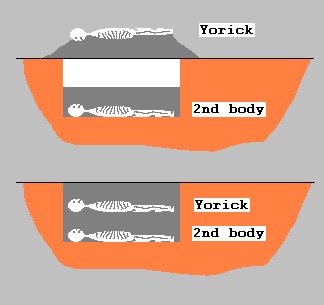A Hamlet timeline - chronicle of events Claudius - planning my foul murder King Hamlet's funeral - where was Hamlet? Gertrude & Claudius - adultery or not? Horatio - Hamlet's friend? Horatio - is he passion's slave? Polonius - the evil that men do Ophelia's love? - did she love Hamlet? Ophelia closetted - Polonius on love O help xxx ....... - Olivier's version Ophelia's change - is Hamlet suspicious? Is Hamlet mad? - Polonius's opinion Hamlet kills Polonius - stabs the "Voice" Ophelia's death - a recipe Hamlet's age - digging up the past Yorick - something rotting in Denmark |
Yorick — something rotting in DenmarkO, a pit of clay for to be madeWhen the gravedigger (Clown) has to dig a grave for Ophelia he does not dig it in new earth but chooses to open Yorick's grave. As well as Yorick, two other bodies are buried in this grave. There must be a reason for this practice. Contemplating the history of this grave may explain why the skull, said to as Yorick's, still smells. The gravedigger is smart when it comes to digging graves. It is hard work to dig damp, clay earth that has never been dug before and so he only digs it out to a depth of about 18 inches. Occasionally he has to dig a deeper grave but he is smart about that, too. Firstly, he finds a grave that is eight or more years old. It needs to be at least eight years because that is how long it takes a body to rot. Because the soil has previously been dug out it is easy work to dig the grave down to its original depth - including throwing out the skeleton. He then needs to dig into the hard earth but again, only to a depth of 18 inches. The new body is then buried and then the old skeleton is thrown into the grave and reburied. Every eight years he can return to the original grave and dig down another 18 inches.
When Ophelia died, Yorick's grave was reopened once again and his skeleton thrown out
Clown: [Sings.] O, a pit of clay for to be made
Clown: Here's a skull now; this skull hath lain in the earth three-and-twenty years.
|



